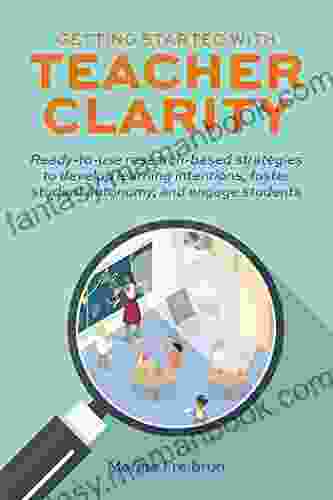Ready-to-Use Research-Based Strategies to Develop Learning Intentions and Foster Student Ownership

As educators, we know that students learn best when they are actively engaged in their learning and have a clear understanding of what they are expected to achieve. By developing learning intentions that are specific, measurable, achievable, relevant, and time-bound (SMART),we can help students to set goals and track their progress towards mastery. We can also foster student ownership of their learning by giving them a voice in the development of learning intentions and by providing them with opportunities to reflect on their progress.
4.6 out of 5
| Language | : | English |
| File size | : | 11763 KB |
| Text-to-Speech | : | Enabled |
| Screen Reader | : | Supported |
| Enhanced typesetting | : | Enabled |
| Word Wise | : | Enabled |
| Print length | : | 152 pages |
| X-Ray | : | Enabled |
In this article, we will provide you with research-based strategies for developing learning intentions and fostering student ownership. These strategies can be used in any subject area and at any grade level.
Developing Learning Intentions
- Start with the end in mind. What do you want your students to know and be able to do by the end of the lesson, unit, or course? Once you know what your learning goals are, you can develop learning intentions that are aligned with those goals.
- Make learning intentions specific. Students need to know exactly what they are expected to learn. Avoid using vague or general language. Instead, be as specific as possible about what students should know and be able to do.
- Make learning intentions measurable. Students need to be able to track their progress towards mastery. Use verbs that can be observed and measured, such as "explain," "demonstrate," or "create."
- Make learning intentions achievable. Students need to believe that they can достичь the learning goals. Set learning intentions that are challenging but not impossible to achieve.
- Make learning intentions relevant. Students need to see how the learning is connected to their lives and to their future goals. Make learning intentions meaningful by connecting them to real-world experiences or to students' personal interests.
- Make learning intentions time-bound. Students need to know when they are expected to достичь the learning goals. Set deadlines for learning intentions so that students can stay on track.
Fostering Student Ownership
- Give students a voice in the development of learning intentions. Ask students what they want to learn and what they think they need to learn. By giving students a voice in the process, you can help them to feel more invested in their learning.
- Provide students with opportunities to reflect on their progress. Regularly ask students to reflect on what they have learned and what they still need to learn. By providing students with opportunities to reflect, you can help them to become more self-aware learners.
- Celebrate student success. When students достичь a learning intention, be sure to celebrate their success. This will help students to feel motivated and to continue to work hard towards their goals.
By implementing these research-based strategies, you can develop learning intentions that are SMART and foster student ownership of learning. By giving students a clear understanding of what they are expected to learn and by providing them with opportunities to take an active role in their learning, you can help them to achieve greater academic success.
4.6 out of 5
| Language | : | English |
| File size | : | 11763 KB |
| Text-to-Speech | : | Enabled |
| Screen Reader | : | Supported |
| Enhanced typesetting | : | Enabled |
| Word Wise | : | Enabled |
| Print length | : | 152 pages |
| X-Ray | : | Enabled |
Do you want to contribute by writing guest posts on this blog?
Please contact us and send us a resume of previous articles that you have written.
 Top Book
Top Book Novel
Novel Fiction
Fiction Nonfiction
Nonfiction Literature
Literature Paperback
Paperback Hardcover
Hardcover E-book
E-book Audiobook
Audiobook Bestseller
Bestseller Classic
Classic Mystery
Mystery Thriller
Thriller Romance
Romance Fantasy
Fantasy Science Fiction
Science Fiction Biography
Biography Memoir
Memoir Autobiography
Autobiography Poetry
Poetry Drama
Drama Historical Fiction
Historical Fiction Self-help
Self-help Young Adult
Young Adult Childrens Books
Childrens Books Graphic Novel
Graphic Novel Anthology
Anthology Series
Series Encyclopedia
Encyclopedia Reference
Reference Guidebook
Guidebook Textbook
Textbook Workbook
Workbook Journal
Journal Diary
Diary Manuscript
Manuscript Folio
Folio Pulp Fiction
Pulp Fiction Short Stories
Short Stories Fairy Tales
Fairy Tales Fables
Fables Mythology
Mythology Philosophy
Philosophy Religion
Religion Spirituality
Spirituality Essays
Essays Critique
Critique Commentary
Commentary Glossary
Glossary Bibliography
Bibliography Index
Index Table of Contents
Table of Contents Preface
Preface Introduction
Introduction Foreword
Foreword Afterword
Afterword Appendices
Appendices Annotations
Annotations Footnotes
Footnotes Epilogue
Epilogue Prologue
Prologue Marilyn Cochran Smith
Marilyn Cochran Smith Julie Coe
Julie Coe Erica Layne
Erica Layne David M Wight
David M Wight Jackie Alpers
Jackie Alpers Liz Isaacson
Liz Isaacson Steve K Bertrand
Steve K Bertrand Marcella Denise Spencer
Marcella Denise Spencer Susanna Clarke
Susanna Clarke Ivy Rose
Ivy Rose Maja Ardal
Maja Ardal Finn Briscoe
Finn Briscoe Simon Martin
Simon Martin Vincent Keler
Vincent Keler Kathy Brennan
Kathy Brennan Mark Bowden
Mark Bowden Moses Yamtal
Moses Yamtal David Bruns
David Bruns Jasper Fforde
Jasper Fforde Lisa Ferrel
Lisa Ferrel
Light bulbAdvertise smarter! Our strategic ad space ensures maximum exposure. Reserve your spot today!

 David PetersonAlpha and Omega Division One: Unveiling the Secrets of an Elite Military Unit
David PetersonAlpha and Omega Division One: Unveiling the Secrets of an Elite Military Unit Yukio MishimaFollow ·18.3k
Yukio MishimaFollow ·18.3k Arthur MasonFollow ·8.4k
Arthur MasonFollow ·8.4k Hugh BellFollow ·4.6k
Hugh BellFollow ·4.6k Dawson ReedFollow ·13.5k
Dawson ReedFollow ·13.5k John UpdikeFollow ·10k
John UpdikeFollow ·10k Christian CarterFollow ·4.9k
Christian CarterFollow ·4.9k Max TurnerFollow ·15k
Max TurnerFollow ·15k VoltaireFollow ·17.4k
VoltaireFollow ·17.4k

 Roland Hayes
Roland HayesFive Unique Eating Plans to Shatter Your Weight Loss...
Weight loss journeys can be a rollercoaster...

 Gustavo Cox
Gustavo CoxThe Small Habits Revolution: How Tiny Changes Can...
Are you ready to...

 Herman Mitchell
Herman MitchellVisit Alook Cool Place In Outer Space Let Explore The...
Welcome to the World Series...

 Hassan Cox
Hassan CoxGaunt's Ghosts Omnibus: A Comprehensive Guide to the Epic...
Prepare to embark on an...
4.6 out of 5
| Language | : | English |
| File size | : | 11763 KB |
| Text-to-Speech | : | Enabled |
| Screen Reader | : | Supported |
| Enhanced typesetting | : | Enabled |
| Word Wise | : | Enabled |
| Print length | : | 152 pages |
| X-Ray | : | Enabled |














